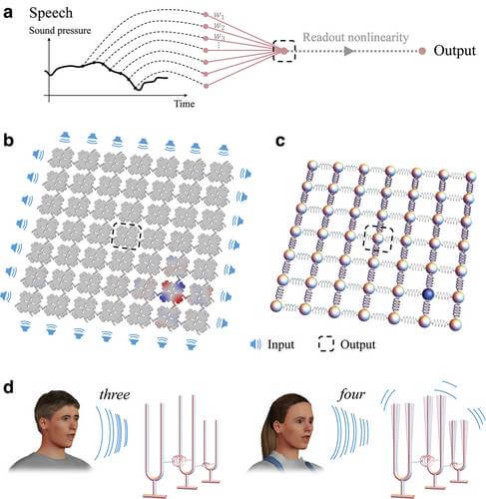Sound-Powered Tech: Energy Harvesting with Phononic Metamaterials
Insights | 13-02-2024 | By Robin Mitchell

Key things to know:
- Exploring phononic metamaterials for innovative energy harvesting and powering devices through sound.
- Addressing the limitations of batteries in modern electronics with sustainable, battery-less solutions.
- Demonstrating the potential of sound to activate devices, reducing energy consumption and environmental impact.
- Highlighting ongoing research and the future possibilities for phononic metamaterials in creating zero-power smart devices.
Harnessing Sound: The Future of Battery-less Electronic Devices
Finding new ways to power electronic devices and eliminate their dependency on batteries and cables has been the focus of many researchers over the decades. Recently, researchers demonstrated how sound can be used to power basic devices, potentially allowing for the creation of battery-less designs. What challenges do batteries introduce into modern electronics, what did the researchers demonstrate, and can sound really be used to power devices?
Innovations in energy harvesting technologies, such as the recent advancements in phononic metamaterials for in-sensor computing, underscore the potential for developing devices that operate beyond traditional power sources. These materials, capable of processing mechanical signals like spoken commands directly, offer a glimpse into a future where electronic devices could function without the need for batteries, leveraging ambient energy sources in novel ways.
What challenges do batteries introduce into modern electronics?
Electronic systems have provided enormous amounts of technological advances over the past century, replacing the need for complex mechanical systems while simultaneously taking over almost all aspects of life. Even though the technology used to create components has changed dramatically, every circuit ever developed has fundamentally required some source of power, and no amount of research will ever change that fact.
The two primary sources of energy available to electronic engineers have either been mains power, which itself is derived from the conversion of some energy source to electricity (such as mechanical motion in turbines, kinetic energy from water, or conversion from light into electricity), and batteries, and both of these have proven to be highly suitable over the years. Mains power is ideal for applications requiring large amounts of power, such as computers, motors, and heaters, while batteries have been invaluable in portable devices, such as radios, torches, and remote controls.
However, the gradual improvements in technology have also seen devices become far more complex, with the introduction of smartphones being an excellent example. With each increase in computational performance, portable devices require more energy to run, and the need for rechargeable batteries further complicates designs.
The Evolution and Impact of Battery Technology
One battery technology that massively helped the field of portable devices is Lithium-ion, thanks to its extremely high energy density. Its ability to be rapidly charged, deliver high currents, and hold massive amounts of energy allows for devices to run for extended periods of time while having the option to draw large instantaneous amounts of power (something which is particularly important for Wi-Fi).
But for all the benefits that such batteries provide, they are not without their downsides. In the case of large-scale IoT deployments, devices will eventually need to be recharged and/or have their batteries replaced, which itself can be a monumental task.
Another issue with using batteries is that they degrade over time, which can lead to a significant amount of e-waste, especially in large-scale deployments. Batteries also run the risk of catastrophic failure depending on the technology they use, and this can see a potential risk of fires (something which can be devastating in remote deployments).
Batteries are also heavily dependent on their environment, meaning that extremes in temperature can reduce their performance. For example, cold temperatures reduce the capacity of batteries due to a reduction in chemical activity, while high temperatures limit the amount of current that can be delivered due to safety reasons.
Finally, sensors that have been deployed may be needed for safety reasons, and taking such sensors offline may not be possible. As such, rapid battery replacements would be needed, which itself introduces other problems, as previously discussed.
Researchers use sound to power circuits
With the numerous issues presented by batteries, many researchers are exploring the use of energy harvesting devices that, as the name suggests, harvest passive energy sources that naturally exist in the environment, such as temperature differences, light, and radio. While such energy sources cannot provide any significant amount of power, they can be collected over a period of time and then used very quickly.
Recognising the potential of energy harvesters, a team of researchers have recently demonstrated a new sound sensor that is able to convert sound into a usable amount of electrical energy for powering small circuits.
The device, which consists of an array of electroacoustic sensors, utilises the pure mechanical energy that sound delivers in the form of vibrations, and these vibrations are directly converted into electrical energy. However, what makes this device rather unique is that instead of absorbing all sound energy, it only reacts to sounds of specific frequency.
As such, the sensor is able to only generate energy when certain words are spoken, allowing for a connected device to wake upon being activated with a specific keyword. This not only eliminates privacy concerns with devices that constantly listen to conversations looking for key phrases but also reduces the energy consumption to zero.
Currently, the sensor is able to differentiate between two or three words, but with further refinement, it is believed that it may be able to distinguish up to 12 different words.
Expanding Capabilities and the Role of Metamaterials
Another interesting feature behind the sensor is that, unlike other sensors which commonly rely on specific material properties, this sensor utilises metamaterials. The property of such materials is defined by their structure, meaning that they could be made from a wide range of various materials to achieve the same function.

Figure 1: Passive speech recognition process using phononic metamaterials. Panel (a) shows speech classification by a temporal convolutional network. Panel (b) depicts the realisation of this network through a lattice metamaterial. Panel (c) models the structure as a mass-spring model, and Panel (d) illustrates the optimised metamaterial as a network of coupled resonators for discriminating between spoken digits.
To illustrate the groundbreaking approach of using phononic metamaterials for passive speech recognition, let's delve into the mechanics of how these materials can be engineered to perform complex tasks such as speech classification. The following figure provides a visual representation of the components and principles behind this innovative technology.
Understanding Phononic Metamaterials for Speech Recognition
In this case, tiny plates are attached to springs whose shape and structure are defined by computer algorithms. Changing the shape and size of the springs allows for different frequencies of sound to be responded to, thereby allowing for different words to activate the sensor array.
The application of phononic metamaterials in creating sensors that can classify speech without the need for power highlights a significant leap towards sustainable and efficient device operation. By designing non-periodic metamaterials that respond selectively to specific sound frequencies, researchers are paving the way for zero-power smart devices. This approach not only promises to reduce the environmental impact of electronic waste but also opens up new possibilities for battery-less electronics in various applications.
Currently, the sensor array is far too large for practical use, but if further refined, it could very well lead to a new ear for battery-less devices.
Can sound really be used to power devices?
The concept of using sound to power devices, while still in its nascent stages, is bolstered by the experimental success of phononic metamaterials in passive speech recognition. These materials demonstrate the feasibility of encoding machine learning tasks into the physical substrate of devices, offering a low-energy alternative to traditional electronic computing. Such advancements suggest that sound, as a ubiquitous and renewable energy source, holds untapped potential for powering future electronic devices.
What the researchers demonstrated is nothing short of brilliance due to the ability of the energy-harvesting device to respond to specific commands. Considering that wake-words are becoming more common in IoT devices, the ability to integrate such features without requiring power could significantly reduce energy consumption, thus extending the lifespan of batteries or outright providing power to perform basic functions.
However, as the technology currently stands, it is far from being suitable for current use due to the large size of the sensor and the miniscule amount of power generated. Even though further improvements in technology may help to increase the power output of the sensor, considering that sound waves typically carry little energy, it is unlikely to ever power electronic devices.
Overall, what the researchers have demonstrated certainly raises eyebrows in the field of responsive designs and energy minimisation, but as an energy harvesting technology, it will unlikely ever be a practical option for engineers looking to rid themselves of tried and tested batteries.
However, the ongoing research into phononic metamaterials and their application in energy harvesting and sound-powered technologies presents a compelling case for optimism. By harnessing the unique properties of these materials, it may be possible to overcome the current limitations, making sound a viable source of power for electronic devices. This aligns with the broader goal of sustainable and environmentally friendly technology development, emphasising the importance of continued innovation in the field.

